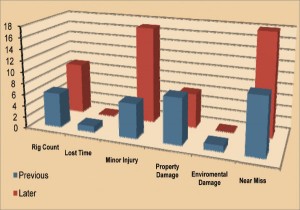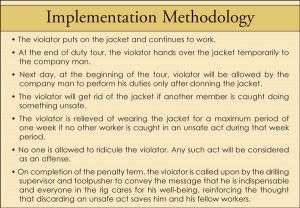Kuwait Oil implements psychology-based program to improve safety behavior
By Mohannad Al-Mehailani, Khaled Al-Hindi, Ashis Gohain, Saleh Muqeem, Safi Akhtar, Abdulwahab Al-Rakdan, Kuwait Oil Company

“Making sure people are not harmed is how we do things in our workplaces” is the slogan consistently instilled into the minds of all personnel at Kuwait Oil Company (KOC). However, despite consistent campaigns for HSE compliance, crew members are often caught in unsafe acts. To minimize such unsafe acts, the KOC Drilling & Workover Team conceptualized and implemented a new approach for improving safety performance through psychology. Proper implementation of this safety program can result in higher effectiveness than some traditional safety programs.
Since the program was launched on a company drilling rig, it has yielded amazing results, with the number of near-misses and incidents declining substantially. The program is ongoing, and efforts are under way to further strengthen its effectiveness.
Rig count increase
KOC’s strategy for increased oil production by 2030 called for a dramatic increase in the number of rigs. This created a pressing demand for increasing the rig count by twofold and to make them fully operational within a span of one year.
With the advent of a vast number of new rigs, the HSE setup within KOC faced a significant challenge to retain standards at the highest levels. Most of the new rigs were quick-moving and environmentally sensitive units equipped with state-of-the-art technologies. They had joystick-operated braking systems, electronic drilling systems, top drives, automated catwalks, iron roughnecks, BOP handling systems, etc.
However, the company recognized that, although technologically advanced equipment plays a big part in ensuring drilling efficiency, it’s really the experience, dedication and knowledge of the crews involved in the process that was key. KOC management recognized that an increased focus on worksite HSE systems would be a key component to achieving the company’s 2030 strategy.
Rig contractors also faced a significant challenge as they strived to mobilize and commission a huge number of rigs within the contractual time frame. Because of the advanced technologies and equipment found on the newly supplied drilling and workover rigs, adequate crew skills were required for correct and safe operation. The recruitment of experienced crews for each rig was undoubtedly an uphill task for all rig contractors.
As new rigs were introduced, the number of safety violations increased substantially. To find the reason for such violations, surprise visits to the rigs were carried out, and one strong reason found was the violator’s attitude. Proper implementation of different safety programs had not made a positive impact on HSE behavior. To put an end to such violations, a new safety approach was undertaken to change crew attitudes.
Rig 38
Rig 38, a KOC-hired drilling unit, was commissioned in April 2009. It is a 1,500-hp rig that was used to drill vertical and directional development wells with a maximum depth of 5,000 ft. The casing design for these wells were fairly typical – 18 5/8 in. at surface, 13 3/8 in. intermediate and 9 5/8-in. for production. The type of completion was either single or dual, depending on the well objective.
In short, the rig was not handling any extraordinary or new operation, yet near-misses, incidents and accidents occurred frequently. Compared with other similar-design rigs conducting similar activities, the number of incidents on Rig 38 was alarmingly high. Despite significant efforts and consistent campaigns for HSE compliance, there was no reduction in incident rates and crews on Rig 38 displayed a declining trend in their HSE behavior. Even senior crew members who knew the potential hazards were caught off-guard committing such unsafe acts.
Injuries were related to crews’ lax working behavior, such as fingers getting trapped at pinch points while housekeeping. Near-misses were also recorded, such as working at height without a safety harness. In one incident, a person was handling a 2-in. gate valve on section A of the wellhead with the help of an air hoist. The valve slipped from the lifting strap and struck the person’s left leg. The individual suffered a fracture in his left leg.
New approach needed

The KOC team desperately underwent several rounds of brainstorming sessions before conceiving of an innovative idea involving human psychology in the form of a safety program called Psychological Effect on HSE Behavior. The program involves a jacket with a slogan printed on the back: “Caught in unsafe act … our company needs you.”
The jacket is kept by the company man on the rig, and any crew member caught in an unsafe act consecutively for the third time must wear the jacket as penalty for the violation. The person must continue to wear the jacket until another crew member is caught doing some unsafe act. The jacket is then passed to the new violator.
The violator is given clemency only for the two unsafe acts committed within that duty cycle.
The team also reviewed existing safety control measures to identify shortcomings. New measures were added, including safety control measures and safety observation and conversations. These efforts involved the use of HSE moments, stop cards, safety logo quizzes, lotteries, daily HSE tours, outdoor parties/barbecues, HSE knowledge evaluations, site verification visits, leadership visits, rig safety audits and training.
Lottery
The lottery is held on a weekly basis by drawing stop cards submitted by crew members. There is no limitation on the number of stop cards that can be submitted by an individual crew member, although each card is scrutinized for HSE relevance by the toolpusher before they can be dropped into the lottery box. Three winners are selected each time, drawn from the box by the drilling supervisor. Winners then read the stop card aloud and explain its contents to his fellow crew members. Failure to explain forfeits the win, and the drawing is repeated. The idea behind the drawing is not only material gain but also to facilitate the development of hazard identification skills and to express them.
Each winner gets an international calling card; the intent is to help him realize that back home he has family members who are solely dependent on him. The personal feeling that the individual experiences after the phone call may help to generate awareness about his personal safety.
Safety Logo Day
Safety Logo Day is held once a month where crews write short safety slogans in four to five words – for example, “No Safety, No Money.” Standard safety slogans are not entertained. All participants are entitled to gifts, and the best slogans along with the participant’s name are displayed in conference rooms and mess halls. T-shirts are generally provided as gifts.
Safety quiz
The safety quiz is another initiative to arouse HSE awareness and enhance safety in the workplace. The quiz date and its topic are announced one week beforehand. One quiz topic was, “How many eye pads are there on your rig and their condition.” Crews would locate the eye pads and check for any abnormality or noncompliance. The quiz is conducted by the drilling supervisor and toolpusher, and three winners are selected based on the nearest correct information provided. High-value prizes such as wrist watches, mobile phones and digital cameras are often awarded to the winners.
Administrative measures
Additional administrative measures to enhance safety included no frequent change of personnel, encouraging friendly behavior among crews, maintaining discipline and obedience and close observation of new crew members.
Engineering measures
Engineering measures that were taken included isolation of source, auto shutoff, auto stops; design, process or procedural changes; monitoring and warning equip ment; well-defined emergency plan for fire, H2S and well control; and drills.
Inspection and certification
Inspection and certification ensured that job-specific safety rules were followed; pre-job safety meetings were conducted; job safety analysis was performed before all critical jobs; hydrogen sulfide training was completed and all employees have a certificate; the H2S monitor and audible alarms were working properly; and periodic equipment inspections and certifications were conducted.
PPE
When it came to personal protective equipment (PPE), it was recognized that PPE should not be used as a substitute for engineering, work practice.
Root cause analysis
 Root cause analyses found these reasons for safety violations: lack of coordination among coworkers; overconfidence concerning jobs; lack of job awareness; poor performance in a team environment despite good individual performance; poor assessment of hazards and risks; and not reporting near-misses.
Root cause analyses found these reasons for safety violations: lack of coordination among coworkers; overconfidence concerning jobs; lack of job awareness; poor performance in a team environment despite good individual performance; poor assessment of hazards and risks; and not reporting near-misses.
Implementing all these measures resulted in maximizing the recognition of safe actions, employees’ overall skills, site safety awareness, employee participation in safety processes and employee skills in making observations. On the other hand, the measures minimized substandard practices, substandard conditions, injuries, incidents, property damage, worker compensation costs and production delays.
Merits of the program were:
- Incident prevention.
- Violator is vigilant in finding an unsafe act among coworkers in order to pass the jacket to another person.
- Better reporting of unsafe acts.
- Crew becomes more aware not to indulge in unsafe acts.
- Crew can differentiate between safe and unsafe acts.
Demerits of the program were:
- Violator may be mentally depressed and lose his concentration.
- Violator may stay focused only to find someone in an unsafe act.
- Could trigger an altercation between coworkers.
Conclusion
KOC is dedicated to identifying, correcting and preventing health, safety and environmental hazards that could adversely affect company employees, service providers’ employees or the general public. Further, management is committed to ensuring that all applicable regulatory health, safety and environmental protection requirements are complied with and that adequate resources are provided to ensure the health and safety of all employees, as well as the preservation of environment.
The ultimate goal is zero incidents. Both KOC and its contractors have greatly increased their loss prevention efforts in recent years. However, one of the toughest problems was coordinating and enforcing safety programs on drilling projects involving multiple contractors supplying different services.
However, as a result of our intense commitment toward proper implementation of all safety programs, the lost-time incident rate has significantly declined over a period of one year. The increase in minor injuries could be attributed to the increased number of rigs. Moreover, better reporting is reflected by a higher number of near-misses in our HSE record.
Achieving results of this kind requires constant management commitment and focus, a trained and knowledgeable work force, work processes and controls that are understandable and enforced and, above all, a culture and belief that our work is never so important that we cannot take the time to do it safely.
Acknowledgements: The authors would like to express their gratitude to Kuwait Oil Company for their permission to publish this paper. We would also like to thank all the rig contractors for contributing their best efforts to making this project successful. This approach relies completely on team effort between operator and service providers; if this had not been achieved, the results would have very different.
